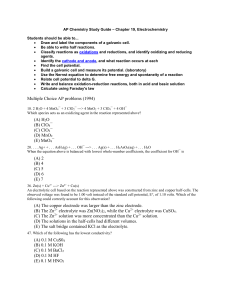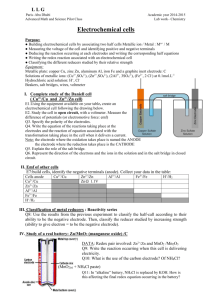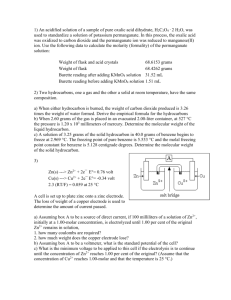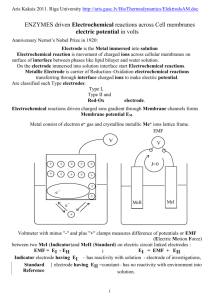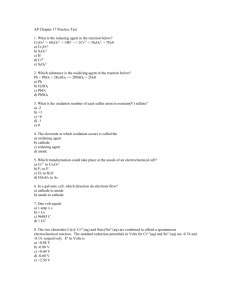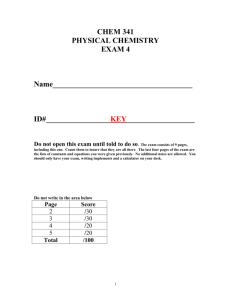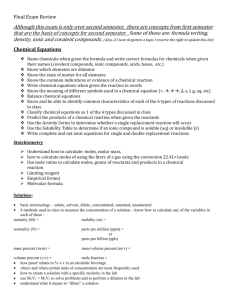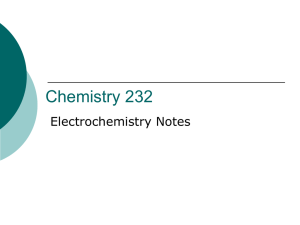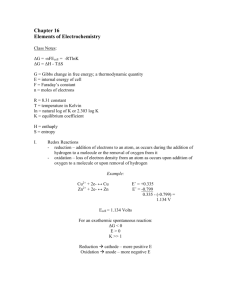Redox Potentials
advertisement
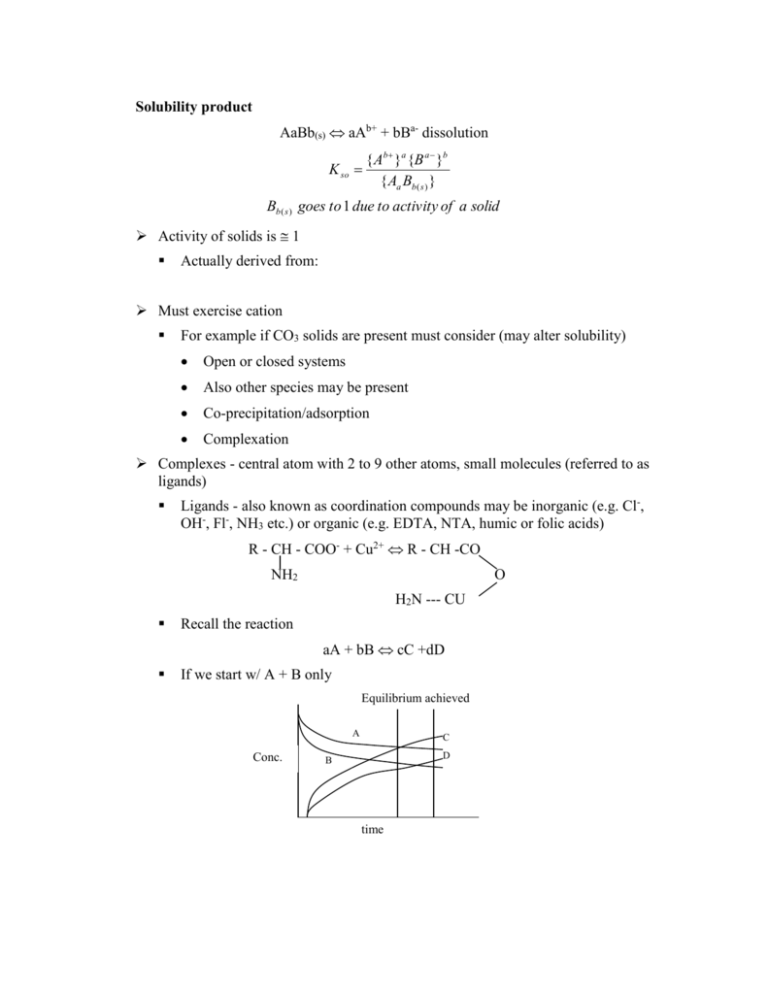
Solubility product
AaBb(s) aAb+ + bBa- dissolution
K so
{ Ab }a {B a }b
{ Aa Bb ( s ) }
Bb ( s ) goes to 1 due to activity of a solid
Activity of solids is 1
Actually derived from:
Must exercise cation
For example if CO3 solids are present must consider (may alter solubility)
Open or closed systems
Also other species may be present
Co-precipitation/adsorption
Complexation
Complexes - central atom with 2 to 9 other atoms, small molecules (referred to as
ligands)
Ligands - also known as coordination compounds may be inorganic (e.g. Cl-,
OH-, Fl-, NH3 etc.) or organic (e.g. EDTA, NTA, humic or folic acids)
R - CH - COO- + Cu2+ R - CH -CO
NH2
O
H2N --- CU
Recall the reaction
aA + bB cC +dD
If we start w/ A + B only
Equilibrium achieved
A
Conc.
C
D
B
time
If we start with C + D only (same equilibrium achieved)
Equilibrium achieved
C
Conc.
A
B
D
time
Free Energy
Change in free energy of reaction = G
G = f(entropy, internal energy, and work)
G = H - TS
Where:
G = Gibbs free energy (kcal)
H = enthalpy (kcal) total energy of compound
T = (R) total part of energy not available to do work
S = entropy (kcal/R) internal energy
For a closed system at constant pressure and temperature "the criterion for
equilibrium is the total free energy is at a minimum."
A + B only
present
G = - rate
GT
Total free
energy
GT,min = min free
energy
Extent of reaction
If G = - rxn proceeds
If G = + rxn will not proceed
G Vi Gi
Vi Gi
i
products i
reac tan ts
Where:
G = change in Gibbs free energy
GI = free energy per mole
If G = 0 then at equilibrium
G = overall standard free energy change
G Vi G f
Vi G f
i
products i
reac tan ts
For example:
CaCO3( s ) H Ca 2 HCO32
G G
G
G
G
f ,CaCO3
f ,HCO3
f ,Ca2
f ,H
From tables:
G 140.31 132.18 269.78 0
G 2.71
It has also been shown that:
G G RT ln K eq
at G 0
G RT ln K eq
Can calculate Keq from free energy calculation
2.71
ln K eq
RT
True for half reactions
1
4
1
2
SO42 H e S 2 H 2 O
6
3
6
3
1
2
1
4
G G 2 G
G
G
2
f
,
H
O
f ,S
f , SO4
f ,H
6
3
6
3
2
G 8.24 kcal mole can proceed
Enthalpy and temperature dependence of equilibrium constants
H G TS
Where:
H = change in enthalpy (heat taken up or released when A + B
completely go to C + D)
S = change in entropy
H H
H
f
f
i
products i
reac tan ts
Van Hoff expression
d ln K H
dT
RT 2
Over a limited range if H f(T) then:
k1 H 1 1
or
k2
R T2 T1
H
ln k
cons tan t
RT
ln
Arrhenius equation:
ln K ln A
Ea
RT
Ea = activation energy
Avg.
Energy
Level
reactants
H
products
Ext of Reaction
A + B products or A + B activated complex products
Ea is the addition energy needed to activate the energy of transfer
complex
Ea + H is given off at end of reaction
Redox Potentials
Chemical energy can be used to create electrical energy and vice versa
Redox chemistry is important in natural and engineered systems
Oxidation – reduction reactions in WWTP are enzyme catalyzed
Driving force for these reactions is free energy of change, which can be directly
related to electrical potentials
External circuit
Electrochemical cell – used to meas. the
potential of half reactions
Sulfate can move across the barrier but not
Cu2+ or Zn2+
Cu
Semi-permeable membrane
Zn
Cu
2+
SO42-
SO42-
Internal Circuit
Zn2+ + 2e- = Zn
Cu2+ +2e- = Cu
If the electrodes are placed in solution over time zinc electrode is pitted, Cu
electrode is deposited open. Electrical potential between the 2 can be measured
and work is done.
From the energy change Cu2+ oxidizes Zn as follows
Zn + Cu2+ = Zn2+ + Cu
If Zn inc. Cu ions are at unit activity then a potential of 1.107 V would be
measured
SO42- would migrate through the semi-permeable membrane to allow for
electroneutrality
With this electrochemical cell the reaction would go to completion
Using a potentiometer a voltage opposing the voltage in the electrochemical cell
is imposed to prevent the flow of current. Concentration remains stable and a
stable reading is obtained.
The cathode is the electrode at which the reduction takes place - cations receive
electrons at this electrode
Anode is electrode in which oxidation takes place - electrons are removed
Electrons always flow from anode to cathode in external circuit
Can make electrochemical cells out of many materials
Potential for any oxidation - reduction rxn is measured against a standard H
electrode
Hydrogen gas is bubbled into a solution to maintain a 1 atm PH2O, and [H+] in unit
activity
Rxns are at 25C and at unit activity ( I2 except e- reduction)
1
I 2 ( aq ) e I , EI , I
2
2
1
H 2 ( g ) H e , EH , H
2
2
1
1
I 2 ( aq ) H 2 ( g ) I H , Ecell
2
2
E E
Ecell
I ,I
H
2
2,H
EI , I 0 EI , I
2
2
Under these conditions the value at:
EI , I s tan dard electrical potential
2
If the value of E = + and all activities = 1 then the rxn proceeds
spontaneously, because G and therefore G = -
Can writ the reactions in terms of G free energy
1
2
I 2( aq) e I
1
G f , I 2 ( aq ) G f , e
2
G 12.35 (.5 * 3.93) 0 14.32
G G f , I
1
H 2( g ) H e
2
1
G G f , H G f , H 2 ( g ) G f , e
2
G 0 0 0 0
For the overall reaction:
G Gred
Goxd
14.32 0 14.32 kcal, will proceed
E is related to G by:
G nFE
n = number of electrons
F = Faradys constant
E = standard potential
Nernst equation:
RT products
ln
nF reac tan ts
G
G
E
E
nF
nF
E E
If
R = 8.314 V-coulombs/equiv
F = 96,500 coulombs/equiv
Then:
E E
0.059 [C ]c [ D]d
log
a
b
n
[ A] [ B]
Example: The ½ rxn for reduction of sulfate to sulfite:
SO42 2 H 2e SO32 H 2 O
What is the standard potential EH of the rxn at 23C if it takes place in 10-3M
SO32-/L and 10-4 moles SO42-/L at pH = 8
From table E = -0.04 V for the half rxn
Applying the Nernst Equation:
EH E
0.059 [ SO32 ]
log 2
2
n
[ H ] [ SO4 ]
0.059
[10 3 ]
E H 0.04
log 8 2 4
2
[10 ] [10 ]
E H 0.50 Volt
ORD E sys E
0.059
[reduced sp ]
log
n
[oxidized sp ]
